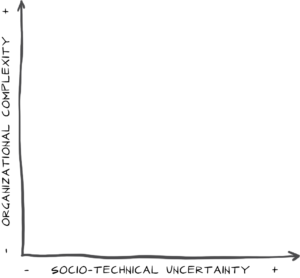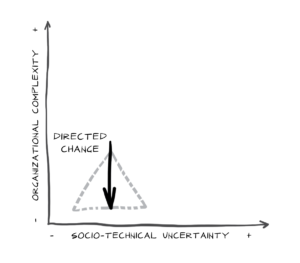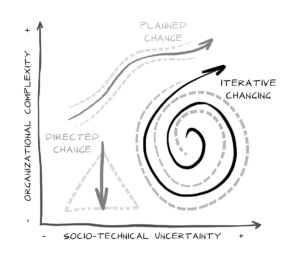3 Change Management Strategies to Lead Transformation
Voices from the Field | Insights 13 November 2018
By Julie Wilson, Institute for the Future of Learning
Our moral obligation is not to stop the future, but to shape it…to channel our destiny in humane directions and to ease the trauma of transition.
Alvin Toffler
Futurist
There is no shortage of ideas for transforming the education system. In the past decade or so, we have witnessed a rising tide of consensus that the acquisition of knowledge is the floor of school performance, and we need to lift our sights higher—preparing our children with the habits of mind that will enable them to thrive in an unknowable future. The national conversation is (at last) shifting from, “How do we close the achievement gap?” to the deeper challenge of addressing the complexity of the relevance gap.
A growing number of school and district strategic plans now call for the nurturing of skills such as creativity, systems thinking, collaboration, and critical thinking. They call for a pedagogy that leans more on high-quality interdisciplinary project-based learning than siloed subjects delivered via lecture and assessed via rote memorization. These plans make a great deal of sense and articulate the essential skills necessary to thrive in an uncertain and ambiguous world. Too often though, adult behavioral change is either glossed over or not considered as a pivotal component of the implementation strategy.
In my work helping school leaders lead change, one of the biggest challenges a leader and their team face is the behavioral shift required to build and nurture the human ability to change. If a bold strategic plan stands a chance of being implemented, it is vital that the adult behavioral shifts are discussed, understood, and nurtured—all in service of the transformational vision laid out in the plan.
These are the most common behavioral shifts I have noticed in my work with leaders and teams implementing change in schools:
Does this resonate with your own experience? Are there shifts you would amend or add? I often think of the above as a continuum. Some situations might require us to lean more towards the left-hand column, and some to the right; but for the most part, the cultural norms of the industrial model of education lean heavily towards the left. We need to build our collective capacity to live more in the right-hand column.
At the core of this work of education transformation is adult transformation. The majority of us were raised in the old industrial system of education, and we find ourselves in the dual role of hospice worker to the old way and midwife to the new (Leicester 2013). It involves a shift away from the mental model of “How do I manage change resistance” to “How do I build change resilience?” This shift is critical.
It is highly unlikely that any five-year school strategic plan will be implemented with 100% fidelity and then enjoy a period of status quo once the plan’s goals have been achieved. Ongoing iterative changing—change that is meaningful and sustainable—is required.
One of the biggest obstacles of transforming the industrial model of education is the industrial model of management that underpins it—a model of command and control. Authority and autonomy are consolidated at the top with limited decision-making ability at the point of delivery (i.e. the relationship between teachers and students).
Is Change Management an Oxymoron
The Industrial era model of change management taught us that implementing change was a linear process. A group of senior leaders would gather around a boardroom table for several meetings to explore, discuss, and decide upon the strategic priorities of the organization. These priorities were then shared with the broader community, ideally resources were assigned, a solid communication plan was implemented to ensure that everyone understood the changes, and change would occur as per the timeline in the strategic plan.
There are (very) few circumstances when this linear approach to change works, but if you are leading the shift away from the industrial model of education, it is woefully inadequate to the task at hand. In their 2009 paper, “Building Organizational Change Capacity,” Anthony Buono and Ken Kerber unpack the complexity of change and identify two major factors to consider when leading change: organizational complexity and socio-technical uncertainty.

Organizational Complexity (vertical axis) refers to the intricacy of the system in which the change is to be implemented. Factors include organizational size, the number of services or programs offered, the extent to which different departments depend on each other for resources, and team interdependence to achieve desired results. The degree of complexity increases the more a change cuts across different departments and hierarchical levels, involves high levels of team interdependence, affects a range of services or programs, and requires the buy-in and support of a wide range of internal and external stakeholders.
Socio-Technical Uncertainty (horizontal axis) refers to the quantity and type of information processing and decision making required to implement the change. This is “based on the extent to which the tasks involved are determined, established or exactly known” (Buono and Kerber). If I am working in a traditional school and I want to shift from “Time-Based Learning” to “Mastery-Based Learning,” there is no cookie cutter model for me to pull off the shelf and implement. It involves an iterative cycle of working through what “I don’t know I don’t know” and a considerable amount of outreach, research, mini pilots, and learning by doing.
Three different types of change emerge at the intersection of these two axes:
1. Directed Change (Low Organizational Complexity, Low Socio-Technical Uncertainty)

This is the kind of change that is low from both an organizational complexity and socio-technical uncertainty perspective. For example, a school district deciding to change the Physics textbook from version 11 to version 12 and mandating the change district-wide. The process to roll out a new textbook is known, the people who will lead the roll-out are readily identified, and the textbook provider likely has several supports in place to orient teachers towards the features of the new textbook.
If a change such as this involves well-known and well-accepted actions in an environment that has the existing systems and processes in place, then directed change is often the most efficient and cost-effective approach. To be effective, this approach also requires a well thought-through communication plan describing the rationale and benefits of the change.
2. Planned Change (High Business Complexity, Low-Medium Socio-Technical Uncertainty)

Many superintendents and principals are familiar with the process of planned change. Given the inherent complexity of a typical school or school district, many change initiatives follow a planned change approach. When it is critical that a large number of diverse stakeholders (i.e. teachers, administrators, students, parents, school board members, and community members) buy-in to the change and support its implementation, a planned approach is needed. The planned approach requires input from key stakeholders in the planning process and strong project management skills.
Helping the community get clear on the ‘why’ of the change, what success will look like, the timeline of activities to implement, a thorough risk analysis, and a solid communication plan are critical components of planned change. Many school and district strategic planning processes follow this approach.
The first year might involve a series of community meetings and focus groups with multiple revisions of priorities by the community and school board. The second year begins the process of implementation and ongoing communication. The more participative the planning process is (by key stakeholders and the ultimate implementers of the change), the higher the chances of the change being sustainable. Implementation may be ongoing over several years.
3. Iterative Changing (High Business Complexity, High Socio-Technical Uncertainty)

This is the land of “you don’t know what you don’t know.” Iterative changing is required when the tasks and processes to implement the change are unknown. Iterative changing requires experimentation and the willingness to fail.
One of the biggest distinctions between planned change and iterative changing is that the change problem itself is unclear. Iterative changing involves giving the work back to the people, knowing that it is up to the people who will implement the change to wrestle with the problem(s) they are trying to solve. This is a significant shift from the patriarchal or matriarchal model of school where the principal or superintendent will tell you what the problem is and, in many cases, provide the solution.
Iterative changing requires facilitative change leadership. As a principal, you might convene a group of teachers and administrators to ask them what is going well and what could be improved with the current change initiative. If the conversation stops there and the principal takes all of the “things that could be improved” on her shoulders to fix, she has just lost a great opportunity for the group to learn and build the capacity to solve their own problems.
Directed change, planned change, and iterative changing are all tools in your change leadership toolkit. If you are leading the change from a traditional model of education to a transformational model, the bulk of your work lives in the area of planned change and cycles of iterative changing. Change in this zone of iterative changing often means you are participating in an evolving and emergent field.
Differentiating Your Approach
Here is a summary of the three approaches to change: their characteristics, goals, process, leadership role, dynamics and pace of change.
Differentiating Approaches to Leading Change (Adapted with permission from Buono and Kerber, 2010)
The lines between these three types of change are blurred. For example, you might start out with a visioning process (planned change) and then shift to forming teams of teachers, students, administrators, and parents to dig into the implementation of several work streams, task forces, or design teams (iterative changing). These teams might go through six months to a year of rapid prototyping and feedback, testing what works and what doesn’t.
Once the data and feedback from these teams are distilled, recommendations might be made. For example, a major redesign of the school schedule, which might result in a mandate (directed change) that the schedule be changed to accommodate team-led, interdisciplinary, project-based learning.
When you reflect on the different change methods available to you, think of a 3D triangle of options as denoted in the above figures and how you might shift from one to the other as the situation and goals suggest. Perhaps a planned change is not the way to go, perhaps it is more appropriate to run a series of pilots (iterative changing) to discover what is actually needed. Your context will help you decide the best way forward.
These three types of change also help us understand that leading change requires managing the polarity of fluidity and stability and navigating the space in between. We are wired from an early age to predict and control. Building change resilience means helping people tolerate the dissonance of the vision we hold and the current reality—and holding the space for the transition between the two.
Leading schools through change requires an adaptive approach. It requires patience and the understanding that, if we are preparing our students for an unknowable future, then we must provide the scaffolding and support for the adults in the system to build the change resilience necessary to lead the work—and when we do that? Well, then we have a real learning organization on our hands—schools that learn.
New resources and news on The Big Idea!
×
We recently announced a new R&D acceleration initiative to connect and support local communities ready to bring public, equitable, learner-centered ecosystems to life.